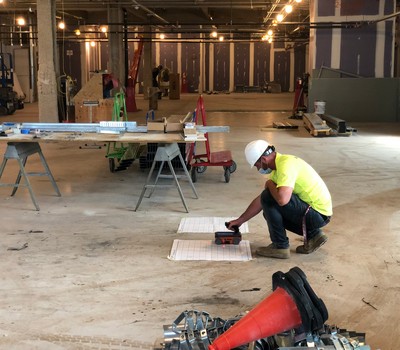The Value of Specific Concrete Scanning in Finding Underground Hazards
The ability to properly identify and map these underground dangers is not just an issue of comfort but an important aspect of ensuring the security of both building workers and the integrity of the project itself. By releasing sophisticated scanning modern technologies and techniques, experts can discover concealed threats, avoid expensive problems, and inevitably pave the method for smoother and safer building endeavors.
Advanced Scanning Technologies for Detection
Sophisticated radar systems are transforming the field of underground discovery by supplying unmatched precision and efficiency. These innovative scanning innovations make use of ground-penetrating radar (GPR) to develop detailed photos of subsurface frameworks, offering insights right into what lies beneath the surface with amazing quality. By emitting high-frequency pulses right into the ground and measuring the representations, radar systems can identify variants in material make-up and discover underground hazards such as cable televisions, pipes, and voids.
One of the vital benefits of these innovative radar systems is their non-invasive nature, permitting for detailed assessments without creating damages to the existing structures. This not only ensures the security of the surrounding setting but additionally minimizes the need for expensive repairs or interruptions to ongoing building tasks. Additionally, the real-time information offered by these scanning modern technologies makes it possible for quick decision-making and enhances general task efficiency.
Importance of Subsurface Mapping

Exact subsurface mapping helps in stopping pricey damages to existing underground framework, lowering the threat of mishaps, and maintaining job timelines. It allows task managers to make enlightened choices relating to website planning, tools release, and source allotment. In addition, subsurface mapping permits far better control among different teams working on a job and helps in abiding by regulative needs connected to underground utility detection.
Mitigating Dangers in Building Projects
Reliable danger mitigation methods are essential for ensuring the success and safety of building tasks. One vital element of mitigating threats in building tasks is complete preparation and analysis at the preliminary phases.
Furthermore, establishing clear interaction channels among all project stakeholders and ensuring stringent adherence to safety procedures are important elements of danger mitigation. By proactively carrying out robust danger mitigation techniques, building webpage and construction tasks can lessen hold-ups, expense overruns, and safety and security events, eventually leading to effective project results.

Preventing Costly Damages and Hold-ups
To reduce economic losses and task obstacles, efficient methods have to be executed to avoid expensive problems and delays in construction jobs. Identifying these obstructions early on helps in preparing the project format a lot more efficiently and avoiding prospective damages throughout excavation.
Additionally, spending in training programs for building and construction employees on the significance of concrete scanning and secure excavation practices can dramatically reduce the danger of mishaps and delays. Clear interaction networks between project supervisors, designers, and on-site workers are additionally important to make certain that everyone knows the potential hazards and complies with the required procedures to stop costly damages. By focusing on proactive steps like concrete scanning and promoting a society of safety and security and understanding, building tasks can reduce the financial effect of unanticipated below ground obstructions and stay clear of costly delays.
Ensuring Safety And Security of On-Site Employee
By focusing on positive measures such as thorough training programs and clear interaction channels, building and construction jobs can make sure the security of on-site personnel in the middle of the possible dangers spotted through concrete scanning. Appropriate training furnishes workers with the expertise and abilities needed to browse construction websites securely, especially when risks are recognized through scanning processes. Training needs to cover threat recognition, emergency situation treatments, and the proper use of individual Recommended Site protective devices to reduce dangers efficiently.
In addition, establishing clear interaction networks is vital for sharing info about identified risks quickly. This makes certain that all on-site workers know potential risks and can take needed precautions to prevent accidents. Normal security briefings, tool kit talks, and regular updates relating to scanning results aid keep everybody educated and aggressive in maintaining a secure working setting.
In addition, carrying out rigorous adherence to safety methods and guidelines, carrying out regular safety and security audits, and fostering a society of security consciousness among workers are vital parts in making sure the well-being of on-site personnel during construction jobs - RainierGPR Concrete Scanning. Positive security measures not only secure employees from injury however also add to the total success and performance of the project
Verdict
Utilizing advanced scanning modern technologies and subsurface mapping assists minimize risks in construction jobs, avoiding pricey damages and delays. It is critical for construction companies to prioritize the use of precise scanning approaches to reduce potential risks and ensure a smooth building and construction procedure.

By proactively like this applying durable risk reduction techniques, construction jobs can minimize hold-ups, expense overruns, and safety cases, ultimately leading to effective task outcomes. - RainierGPR Concrete Scanning
To decrease monetary losses and task troubles, reliable techniques must be executed to stop expensive damages and hold-ups in building tasks. By focusing on proactive procedures like concrete scanning and advertising a society of safety and security and recognition, building and construction tasks can minimize the monetary impact of unforeseen underground blockages and stay clear of expensive delays.
By prioritizing positive steps such as thorough training programs and clear interaction channels, building tasks can ensure the safety of on-site personnel amidst the potential dangers spotted via concrete scanning. Using sophisticated scanning modern technologies and subsurface mapping assists reduce dangers in building and construction projects, stopping expensive damages and hold-ups.